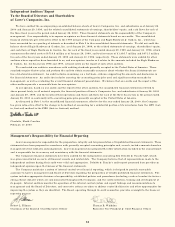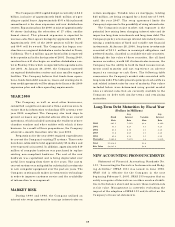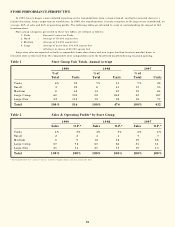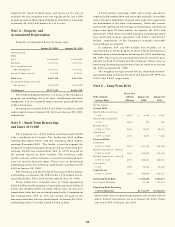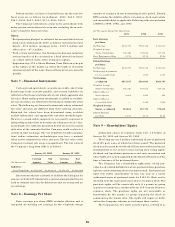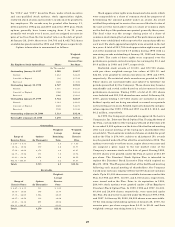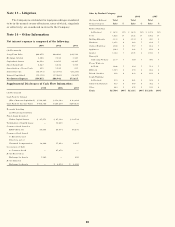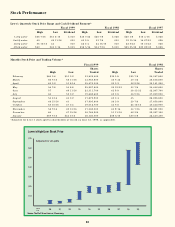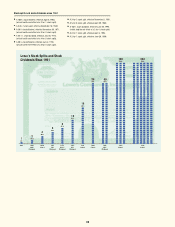Lowe's 1999 Annual Report Download - page 26
Download and view the complete annual report
Please find page 26 of the 1999 Lowe's annual report below. You can navigate through the pages in the report by either clicking on the pages listed below, or by using the keyword search tool below to find specific information within the annual report.
24
straight-line method. Leasehold improvements are depreciated
over the shorter of their estimated useful lives or term of the
related lease.
Leases – Assets under capital leases are amortized in accor-
dance with the Co mpany’s normal depreciation policy for o wned
assets or over the lease term, if shorter, and the charge to
earnings is included in depreciation expense in the consolidated
financial statements.
Income Taxes – Income taxes are provided for temporary
differences between the tax and financial accounting bases of
assets and liabilities using the liability method. The tax effects of
such differences are reflected in the balance sheet at the enacted
tax rates expected to be in effect when the differences reverse.
Store Pre-opening Costs – Costs of opening new retail
stores are charged to operations as incurred.
Impairment/Store Closing Costs – Losses related to impair-
ment of long-lived assets and for long-lived assets to be disposed
of are recognized when expected future cash flows are less than
the assets’ carrying value. At the time management commits to
close or relocate a store location, the Company evaluates the
carrying value of the assets in relation to its expected future cash
flows. If the carrying value of the assets is greater than the
expected future cash flows, a provision is provided for the
impairment of the assets. When a leased location becomes
impaired, a provision is provided for the present value of future
lease obligations, net of anticipated sublease income. Provisions
for impairment and store closing costs are included in selling,
general and administrative expenses.
The estimated realizable value of closed store real estate is
included in other assets and amounted to $56.4 and $62.3
million at January 28, 2000 and January 29, 1999, respectively.
Revenue Recognition – The Company recognizes revenues
when sales transactions occur and customers take possession of
the merchandise.
Advertising – Costs associated with advertising are charged to
operations as incurred. Advertising expenses were $69.2, $116.5
and $133.7 million for 1999, 1998 and 1997, respectively.
Recent Accounting Pronouncements – Statement of Finan-
cial Accounting Standards No. 133, “Accounting for Derivative
Instruments and Hedging Activities” (SFAS 133) was issued in
June 1998. SFAS 133 is effective for the Company in the year
beginning February 3, 2001. SFAS 133 requires that an entity
reco gnize all derivatives as either assets o r liabilities in the balance
sheet and measure those instruments at fair value. Management
is currently evaluating the impact of the adoption of SFAS 133
and its effect on the Company’s financial statements.
Note 2 – Merger
The Company completed its merger with Eagle Hardware &
Garden, Inc. (Eagle) on April 2, 1999. The transaction was
structured as a tax-free exchange of the Company’s common
stock for Eagle’s common stock, and was accounted for as a
pooling of interests. Lowe’s issued .64 shares of common stock
for each share of Eagle outstanding common stock. Approxi-
mately 21.8 million shares of the Company’s common stock
were issued as a result of the merger, and Eagle’s outstanding
stock options were converted into options to purchase approxi-
mately 923,000 common shares. The Company incurred $24.4
million of merger related costs which were charged to operations
during the first quarter of fiscal year 1999. These costs consisted of
$15.7 million relating to the write-o ff of no nusable Eagle properties,
$1.5 million for severance obligations to former Eagle executives,
and $7.2 million in direct merger costs such as accounting, legal,
investment banker and other miscellaneous fees.
As a result of the merger, all current and historical financial
information is being presented on a combined basis. No adjust-
ments were necessary to conform the accounting principles of
the two Companies.
The following table presents a reconciliation of net sales and
net earnings previously reported by the Company to those pre-
sented in the accompanying consolidated statements of earnings.
January 29, 1999 January 30, 1998
(In Thousands)
Net Sales:
Lowe’s $12,244,882 $10,136,890
Eagle 1,085,658 971,488
Combined $13,330,540 $11,108,378
Net Earnings:
Lowe’s $ 464,043 $ 353,114
Eagle 36,332 29,916
Combined $ 500,375 $ 383,030
Note 3 – Investments
The amortized cost, gross unrealized holding gains and losses
and fair values of investment securities, all of which are classified
as available-for-sale securities, at January 28, 2000 and January
29, 1999 are as follows:
January 28, 2000
(In Thousands) Amortized Gross Unrealized Fair
Type Cost Gains Losses Value
Municipal Obligations $ 10,668 $ 12 $ 10 $ 10,670
Money Market Preferred Stock 67,000 — — 67,000
Classified as Short-Term 77,668 12 10 77,670
Municipal Obligations –
Classified as Long-Term 31,761 8 655 31,114
Total $109,429 $ 20 $665 $108,784
January 29, 1999
(In Thousands) Amortized Gross Unrealized Fair
Type Cost Gains Losses Value
Municipal Obligations $ 20,211 $132 — $ 20,343
Money Market Preferred Stock — — — —
Classified as Short-Term 20,211 132 — 20,343
Municipal Obligations –
Classified as Long-Term 28,207 554 $ 45 28,716
Total $ 48,418 $686 $ 45 $ 49,059
The proceeds from sales of available-for-sale securities were
$17.1, $37.5 and $14.3 million for 1999, 1998 and 1997,


